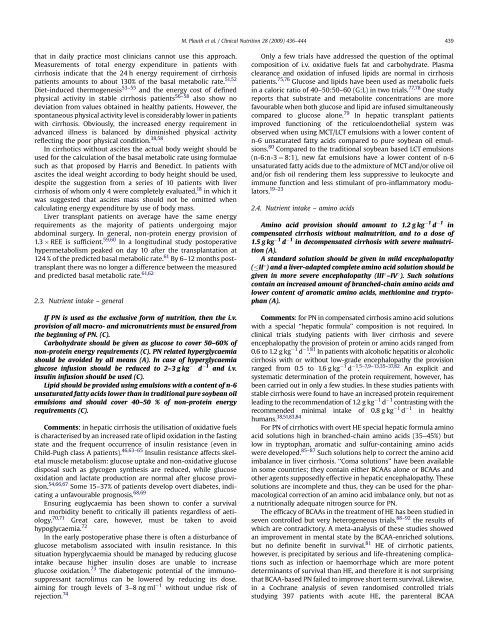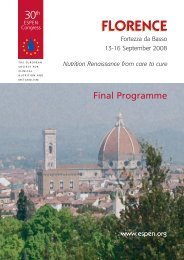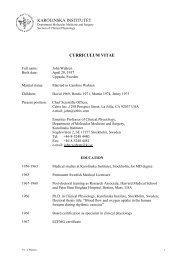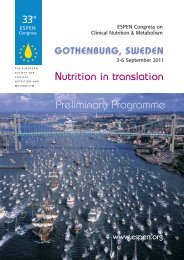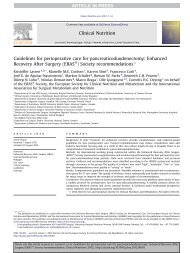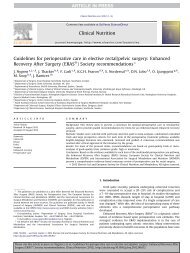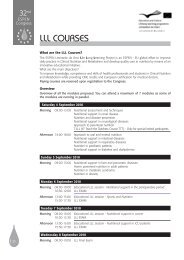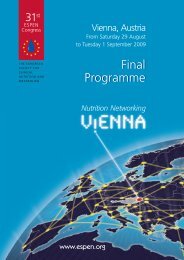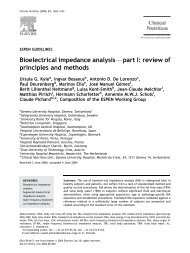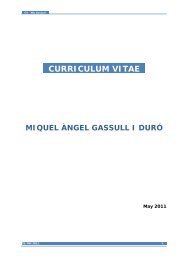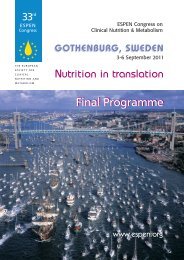ESPEN Guidelines on Parenteral Nutrition: Hepatology
ESPEN Guidelines on Parenteral Nutrition: Hepatology
ESPEN Guidelines on Parenteral Nutrition: Hepatology
You also want an ePaper? Increase the reach of your titles
YUMPU automatically turns print PDFs into web optimized ePapers that Google loves.
that in daily practice most clinicians cannot use this approach.<br />
Measurements of total energy expenditure in patients with<br />
cirrhosis indicate that the 24 h energy requirement of cirrhosis<br />
patients amounts to about 130% of the basal metabolic rate. 51,52<br />
Diet-induced thermogenesis 53–55 and the energy cost of defined<br />
physical activity in stable cirrhosis patients 56–58 also show no<br />
deviati<strong>on</strong> from values obtained in healthy patients. However, the<br />
sp<strong>on</strong>taneous physical activity level is c<strong>on</strong>siderably lower in patients<br />
with cirrhosis. Obviously, the increased energy requirement in<br />
advanced illness is balanced by diminished physical activity<br />
reflecting the poor physical c<strong>on</strong>diti<strong>on</strong>. 38,58<br />
In cirrhotics without ascites the actual body weight should be<br />
used for the calculati<strong>on</strong> of the basal metabolic rate using formulae<br />
such as that proposed by Harris and Benedict. In patients with<br />
ascites the ideal weight according to body height should be used,<br />
despite the suggesti<strong>on</strong> from a series of 10 patients with liver<br />
cirrhosis of whom <strong>on</strong>ly 4 were completely evaluated, 18 in which it<br />
was suggested that ascites mass should not be omitted when<br />
calculating energy expenditure by use of body mass.<br />
Liver transplant patients <strong>on</strong> average have the same energy<br />
requirements as the majority of patients undergoing major<br />
abdominal surgery. In general, n<strong>on</strong>-protein energy provisi<strong>on</strong> of<br />
1.3 REE is sufficient. 59,60 In a l<strong>on</strong>gitudinal study postoperative<br />
hypermetabolism peaked <strong>on</strong> day 10 after the transplantati<strong>on</strong> at<br />
124 % of the predicted basal metabolic rate. 61 By 6–12 m<strong>on</strong>ths posttransplant<br />
there was no l<strong>on</strong>ger a difference between the measured<br />
and predicted basal metabolic rate. 61,62<br />
2.3. Nutrient intake – general<br />
If PN is used as the exclusive form of nutriti<strong>on</strong>, then the i.v.<br />
provisi<strong>on</strong> of all macro- and micr<strong>on</strong>utrients must be ensured from<br />
the beginning of PN. (C).<br />
Carbohydrate should be given as glucose to cover 50–60% of<br />
n<strong>on</strong>-protein energy requirements (C). PN related hyperglycaemia<br />
should be avoided by all means (A). In case of hyperglycaemia<br />
glucose infusi<strong>on</strong> should be reduced to 2–3 g kg d 1 and i.v.<br />
insulin infusi<strong>on</strong> should be used (C).<br />
Lipid should be provided using emulsi<strong>on</strong>s with a c<strong>on</strong>tent of n-6<br />
unsaturated fatty acids lower than in traditi<strong>on</strong>al pure soybean oil<br />
emulsi<strong>on</strong>s and should cover 40–50 % of n<strong>on</strong>-protein energy<br />
requirements (C).<br />
Comments: in hepatic cirrhosis the utilisati<strong>on</strong> of oxidative fuels<br />
is characterised by an increased rate of lipid oxidati<strong>on</strong> in the fasting<br />
state and the frequent occurrence of insulin resistance (even in<br />
Child-Pugh class A patients). 46,63–65 Insulin resistance affects skeletal<br />
muscle metabolism: glucose uptake and n<strong>on</strong>-oxidative glucose<br />
disposal such as glycogen synthesis are reduced, while glucose<br />
oxidati<strong>on</strong> and lactate producti<strong>on</strong> are normal after glucose provisi<strong>on</strong>.<br />
54,66,67 Some 15–37% of patients develop overt diabetes, indicating<br />
a unfavourable prognosis. 68,69<br />
Ensuring euglycaemia has been shown to c<strong>on</strong>fer a survival<br />
and morbidity benefit to critically ill patients regardless of aetiology.<br />
70,71 Great care, however, must be taken to avoid<br />
hypoglycaemia. 72<br />
In the early postoperative phase there is often a disturbance of<br />
glucose metabolism associated with insulin resistance. In this<br />
situati<strong>on</strong> hyperglycaemia should be managed by reducing glucose<br />
intake because higher insulin doses are unable to increase<br />
glucose oxidati<strong>on</strong>. 73 The diabetogenic potential of the immunosuppressant<br />
tacrolimus can be lowered by reducing its dose,<br />
aiming for trough levels of 3–8 ng ml 1 without undue risk of<br />
rejecti<strong>on</strong>. 74<br />
M. Plauth et al. / Clinical Nutriti<strong>on</strong> 28 (2009) 436–444 439<br />
Only a few trials have addressed the questi<strong>on</strong> of the optimal<br />
compositi<strong>on</strong> of i.v. oxidative fuels fat and carbohydrate. Plasma<br />
clearance and oxidati<strong>on</strong> of infused lipids are normal in cirrhosis<br />
patients. 75,76 Glucose and lipids have been used as metabolic fuels<br />
in a caloric ratio of 40–50:50–60 (G:L) in two trials. 77,78 One study<br />
reports that substrate and metabolite c<strong>on</strong>centrati<strong>on</strong>s are more<br />
favourable when both glucose and lipid are infused simultaneously<br />
compared to glucose al<strong>on</strong>e. 79 In hepatic transplant patients<br />
improved functi<strong>on</strong>ing of the reticuloendothelial system was<br />
observed when using MCT/LCT emulsi<strong>on</strong>s with a lower c<strong>on</strong>tent of<br />
n-6 unsaturated fatty acids compared to pure soybean oil emulsi<strong>on</strong>s.<br />
80 Compared to the traditi<strong>on</strong>al soybean based LCT emulsi<strong>on</strong>s<br />
(n-6:n-3 ¼ 8:1), new fat emulsi<strong>on</strong>s have a lower c<strong>on</strong>tent of n-6<br />
unsaturated fatty acids due to the admixture of MCT and/or olive oil<br />
and/or fish oil rendering them less suppressive to leukocyte and<br />
immune functi<strong>on</strong> and less stimulant of pro-inflammatory modulators.<br />
19–23<br />
2.4. Nutrient intake – amino acids<br />
Amino acid provisi<strong>on</strong> should amount to 1.2 g kg 1 d 1 in<br />
compensated cirrhosis without malnutriti<strong>on</strong>, and to a dose of<br />
1.5 g kg 1 d 1 in decompensated cirrhosis with severe malnutriti<strong>on</strong><br />
(A).<br />
A standard soluti<strong>on</strong> should be given in mild encephalopathy<br />
( II ) and a liver-adapted complete amino acid soluti<strong>on</strong> should be<br />
given in more severe encephalopathy (III –IV ). Such soluti<strong>on</strong>s<br />
c<strong>on</strong>tain an increased amount of branched-chain amino acids and<br />
lower c<strong>on</strong>tent of aromatic amino acids, methi<strong>on</strong>ine and tryptophan<br />
(A).<br />
Comments: for PN in compensated cirrhosis amino acid soluti<strong>on</strong>s<br />
with a special ‘‘hepatic formula’’ compositi<strong>on</strong> is not required. In<br />
clinical trials studying patients with liver cirrhosis and severe<br />
encephalopathy the provisi<strong>on</strong> of protein or amino acids ranged from<br />
0.6 to 1.2 g kg 1 d 1 . 81 In patients with alcoholic hepatitis or alcoholic<br />
cirrhosis with or without low-grade encephalopathy the provisi<strong>on</strong><br />
ranged from 0.5 to 1.6 g kg 1 d 1 . 5–7,9–13,35–37,82 An explicit and<br />
systematic determinati<strong>on</strong> of the protein requirement, however, has<br />
been carried out in <strong>on</strong>ly a few studies. In these studies patients with<br />
stable cirrhosis were found to have an increased protein requirement<br />
leading to the recommendati<strong>on</strong> of 1.2 g kg 1 d 1 c<strong>on</strong>trasting with the<br />
recommended minimal intake of 0.8 g kg 1 d 1<br />
in healthy<br />
humans. 38,51,83,84<br />
For PN of cirrhotics with overt HE special hepatic formula amino<br />
acid soluti<strong>on</strong>s high in branched-chain amino acids (35–45%) but<br />
low in tryptophan, aromatic and sulfur-c<strong>on</strong>taining amino acids<br />
were developed. 85–87 Such soluti<strong>on</strong>s help to correct the amino acid<br />
imbalance in liver cirrhosis. ‘‘Coma soluti<strong>on</strong>s’’ have been available<br />
in some countries; they c<strong>on</strong>tain either BCAAs al<strong>on</strong>e or BCAAs and<br />
other agents supposedly effective in hepatic encephalopathy. These<br />
soluti<strong>on</strong>s are incomplete and thus, they can be used for the pharmacological<br />
correcti<strong>on</strong> of an amino acid imbalance <strong>on</strong>ly, but not as<br />
a nutriti<strong>on</strong>ally adequate nitrogen source for PN.<br />
The efficacy of BCAAs in the treatment of HE has been studied in<br />
seven c<strong>on</strong>trolled but very heterogeneous trials, 88–92 the results of<br />
which are c<strong>on</strong>tradictory. A meta-analysis of these studies showed<br />
an improvement in mental state by the BCAA-enriched soluti<strong>on</strong>s,<br />
but no definite benefit in survival. 81 HE of cirrhotic patients,<br />
however, is precipitated by serious and life-threatening complicati<strong>on</strong>s<br />
such as infecti<strong>on</strong> or haemorrhage which are more potent<br />
determinants of survival than HE, and therefore it is not surprising<br />
that BCAA-based PN failed to improve short term survival. Likewise,<br />
in a Cochrane analysis of seven randomised c<strong>on</strong>trolled trials<br />
studying 397 patients with acute HE, the parenteral BCAA


